Research shows that more than 80% of internet users now own a smartphone. This means that a major percentage of your target audience is accessing your content via the palm of their hands. Does your marketing strategy take this consideration into account? While digital strategists aim to make campaigns as customer-focused and tech-savvy as possible, many deeply undervalue the importance of creating collateral that is as accessible and responsive as it is dynamic and informative.
Taking steps to mobilize your marketing isn’t just good business sense. By doing so, you’ll better prepare your brand for the future of advertising, most of which will be performed on increasingly smaller screens in an even faster-paced setting than we’re used to seeing. To this end, let’s explore a few reasons why mobile will reign supreme in 2019 and beyond.
1. Your SEO Rankings Depend on It
In recent years, appearing at or near the top of the page on Google search results has taken center stage as a chief marketing aim. After all, gaining access to this coveted spot can vastly improve visibility and increase conversions. In fact, the most recent industry statistics reveal that those websites listed in the first position of online search results gain around 33% of the overall traffic share. From there, the second position gets about 15%, while the third spot gets 9%.
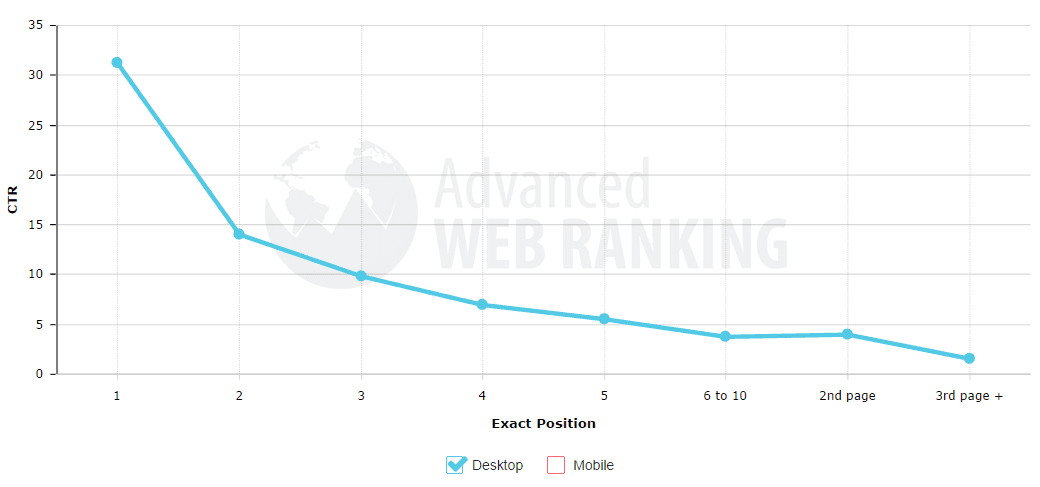
Moz: Google Organic Click-Through Rates in 2014
What does this mean for your company? In short, it means that if you can manage to get your website to the top of local search results, you’ll have a 33% greater opportunity of someone clicking on your content. You’ll get there by implementing strategic Search Engine Optimization (SEO) strategies. While much of your SEO ranking will depend on the content available on your website and how well you craft it to include inbound/outbound links, keywords and phrases, meta titles, descriptions and more, there are other ways you can boost your odds, as well. Chiefly, you can ensure your content is mobile-ready.
This year, Google saw its highest mobile search numbers to date, with 52.2% coming from mobile devices as opposed to laptops or desktops. In turn, the search engine giant announced in March 2018 that it would be rolling out mobile-first indexing. This means that, rather than indexing your website based on its desktop version, they’re looking at your mobile version first. Are images slow to load? Is text hard to read across the screen? Do graphics look wonky and out of context and is the layout all over the place? It doesn’t matter anymore if your website operates like a charm when fired up on a desktop. If it’s not user-friendly in a mobile version, Google will deduct major points from your SEO ranking.
This focus on mobile by Google is nothing new. Developers will recall that in 2015, Google announced an update referred to many in the industry as “Mobilegeddon.” This update essentially hurt websites that weren’t mobile-friendly and rewarded those that were. As a result, sites that failed to make the switch before the 2015 update saw a more than 50% reduction in traffic as their visibility and traffic waned.
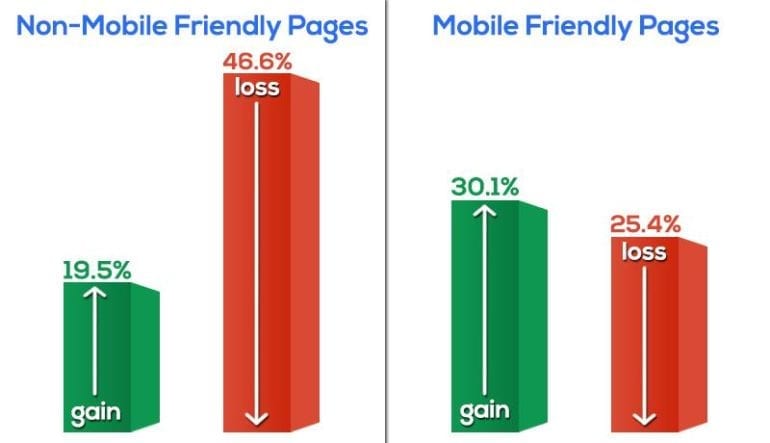
Stone Temple: Mobilegeddon: Nearly 50% of Non-Mobile Friendly URLs Dropped in Rank
If you’re still on the fence about investing in a mobile-first marketing strategy, the statistics above point to its heightened importance. After the 2015 update alone, those website that were optimized for mobile saw a 30% jump in traffic while those that weren’t ready for the change only gained around 19%.
[insert page=’6-essential-tips-for-keeping-your-content-relevant-and-ranking’ display=’single-related-article-02.php’]
2. You’ll Reach a Wider Audience
Though it might have been considered technological blasphemy only a decade ago, there is now a growing population of web users that access the internet via a mobile device only, eschewing a larger desktop or laptop altogether. Data from the Pew Research Center shows that 77% of Americans now own a smartphone while only around 75% own a computer.
Those quick to jump to the point might assume that Millennials comprise the demographic most likely to own only a smartphone. However, industry insights reveal that the 35-49 age bracket claims this spot, with a 96% mobile adoption rate. Conversely, the 18-34 age bracket comes in at only 91%. Keeping this in mind, many top brands are focusing on this age group in their mobile marketing campaigns. Take the recent “Sun Band” campaign created through a partnership between Nivea and FCB São Paolo.
The campaign was developed as a combination print and mobile one. Customers could pop a bracelet out of the print advertisement, wrap it around their kid’s wrist, and sync it to their smartphone via a speciality app. From there, they could set a safety perimeter, where they’d receive mobile alerts if their child wandered outside of the zone. As persons aged 35-49 are most likely to have older children who can play by themselves but should still remain under parental guidance, this was an ideal way to reach that coveted smartphone audience.
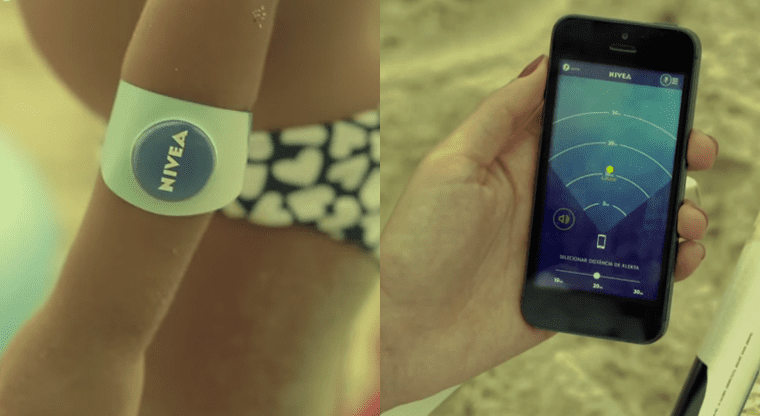
SpringWise: Print Ad is Also a Wristband
While this reveals the role that mobile apps can play in a greater marketing campaign, it also demonstrates the importance of speaking to your target audience.
Yet, specifics aside, it’s important for marketers to keep in mind that alienating an entire demographic alone can prove detrimental to any brand, especially a small-to-medium-sized business that’s dependent on exposure for continued growth. That’s where targeted mobile marketing comes into play, and it cannot be achieved if links back to a company’s website lead to an ill-prepared layout that causes web users to quickly click away or onto a competitor’s site instead.
3. It Amplifies Your Social Media Advertising Campaign
Recently, social media platforms have realized the importance of mobile advertising and have made it easier than ever before to allow brands to target mobile users. Considering that nearly 80% of social media use now happens on mobile devices, it’s important that your content be as easy to access and simple to navigate for these users.
This is especially the case if you’re developing a niche mobile app rather than a static landing page, to convert web visitors and boost sales. You can advertise this app across the myriad social media platforms to reach customers that are focused on your specific industry vertical. For instance, by taking out a Facebook ad, you can discuss your mobile app download in greater detail, provide a link to it, and reach a greater audience than you would have by simply posting a button to it on your website. For a visual example, consider the case of the Marriott International mobile ad below.
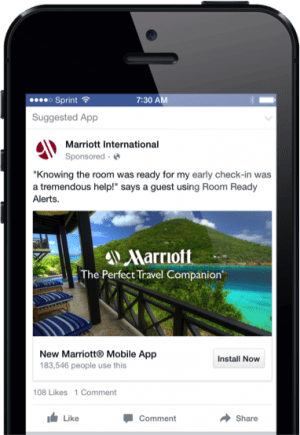
Business2Community: New Facebook Ad Strategies That Will Reinvent Your Mobile Marketing
Here, users can easily see the link to the mobile app “install now” download, as well as a customer testimonial, follower “likes” and other helpful information. By merging social media marketing strategies with a mobile-first focus, forward-thinking brands can see increased visibility across the board. This is especially the case when marketing to a specific niche or target audience.
[insert page=’how-to-boost-your-content-strategy-with-data’ display=’single-related-article.php’]
4. It’s More Interactive Than Ever Before
Gone are mobile campaigns that simply brought web visitors back to a company’s web page for more information. Rather, today’s outreach strategies are more interactive and dynamic than ever before, integrating elements that range from virtual and augmented reality (VR, AR) to artificial intelligence (AI) and a host of features in between.
Most marketers might think of gamification when they consider how these elements can be used to supplement an existing campaign. It’s not difficult to see why: The Pokémon Go craze alone was enough to show hopeful advertising leaders how including simple elements of AR can elevate a ho-hum campaign into a worldwide phenomenon if the strategy is correct. Yet, games are far from the only way that AR and its related features can be used to support a mobile strategy.
Consider, for example, what happens when you use your smartphone to scan a bottle of Heinz ketchup. You’ll have access to a host of recipes, product information and more with the simple swipe of a screen. Or, smaller companies can use AR tools to allow customers to “try” their products before committing to a purchase. This strategy was deployed by the app Ink Hunter. Here, users can see how a certain tattoo will look on their bodies before they go in for the permanent thing.

NoRiskSEO: How Augmented Reality Can Fit Into Your Small Business Marketing Plan
Of course, determining how to best integrate multiple digital elements together to create a cohesive marketing campaign can be a challenging task. The idea is to use all of the best technology-rich features in a way that offers a seamless and streamlined customer experience. While your in-house development and support staff may be able to work together to create a comprehensive plan, a digital strategist is often needed to make all of the elements work together to increase appeal and build your bottom line. By bringing on on board, you can get a bigger-picture view of your overall campaign and how to use mobile elements to enrich, rather than take away from it.
5. You’ll Reach Your Audience on a Personal Level
It’s one thing for someone to click on your link while at their work computer. It’s an entirely different thing for them to access your content while they’re scrolling at the kitchen table or on the subway to the office. At their core, mobile devices are personal. They’re usually carried on our person and they’re never too far from arm’s reach.
Keeping this in mind, brands can use mobile marketing to reach their audience on their own terms, at their convenience. Keep in mind that one study found that smartphone users check their mobile devices up to 80 times per day! Now, think of the impact your brand could have if your content is appearing at the top of their search screen or on their social media pages. That’s an incredible reach, and makes it far worth the investment it takes to get your content mobile-ready. That means, if your website still looks like the one on the left when viewed on a smartphone, it’s time to hold a developer’s meeting to get all staff on board with the conversion.
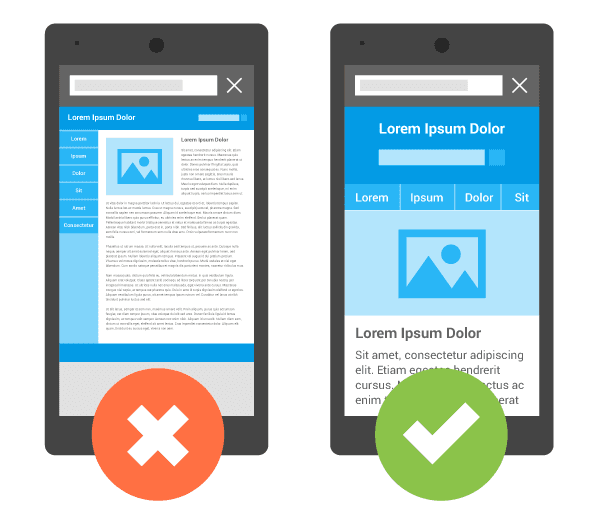
Google: Mobile Site Guide
In most cases, you won’t need to entirely overhaul your existing content. Rather, there are a few checklist items you’ll need to follow to get mobile responsiveness right. They include considerations such as fluid images, responsive videos, strategic break points, meta viewpoint elements and more. For a more comprehensive list of design tips, this list offers a great place to start, especially if you’re interested in boosting your mobile SEO efforts.
[insert page=’how-to-use-semrush-to-conduct-the-perfect-keyword-research-your-e-commerce-store’ display=’single-related-article-02.php’]
Moving Forward: Making Mobile Marketing Work for Your Brand
You’re in business to convert prospects, cater to your customers and grow your sales along the way. As more consumers lean toward mobile devices, it stands to reason that brands without a focused mobile strategy will pay the price, especially as search engine giants including Google continue to emphasize its importance.
Before getting started, take an inventory of your existing content and your current marketing strategies. Then, take steps to convert them at the same time, so the result is a comprehensive campaign that’s as accessible as it is attractive. Not only will you grow your exposure, but you’ll also inch higher in search rankings and click rates as your content finally gains the handheld visibility it deserves.





